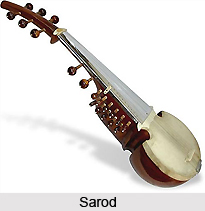 Sarod is one of the leading concert instruments of North Indian Classical Music. This string instrument is most likely non-Indian in origin. The Sarod has four melody strings tuned to Sa, Pa, Sa, Ma and it is played with a triangular plectrum.
Sarod is one of the leading concert instruments of North Indian Classical Music. This string instrument is most likely non-Indian in origin. The Sarod has four melody strings tuned to Sa, Pa, Sa, Ma and it is played with a triangular plectrum.Structure of Sarod
It has a hollow circular belly to which is attached a tapering neck whose slim top portion holds the tuning pegs. Therefore it is a lute-type instrument. The shape of the belly of the instrument is distinctive in that it is pinched just below the place where the neck is attached. The use of wood for the belly of the Sarod and the use of parchment to cover the belly were retained from Rebab construction. The Sarod is usually three to three and a half feet long and has a body of teakwood overlaid with a fingerboard of polished metal, which facilitates sliding the finger along the strings. One of the distinctive features of the Sarod is that unlike the other string instruments it does not have a fret. The job of the frets is done by the left hand which is used for stopping the strings along the smooth fingerboard.
History of Sarod
The details of its development in India are quite different to trace. In all likelihood, it originated from the Rebab, an instrument from the Middle East. Its use in Indian Classical Music can be traced back to one of the master musicians of Indian music, Tansen. He was one of the most fantastic singers andBbinkars in the court of the Mughal emperor Akbar. Today, the Rebab has been replaced by the Sarod in the performances of Indian Classical music. It is said that Khan Saheb Asadullah Khan introduced the Sarod in Bengal over a century ago, and since then Bengal has become noted for the manufacture and popularization of this instrument.
It has a hollow circular belly to which is attached a tapering neck whose slim top portion holds the tuning pegs. Therefore it is a lute-type instrument. The shape of the belly of the instrument is distinctive in that it is pinched just below the place where the neck is attached. The use of wood for the belly of the Sarod and the use of parchment to cover the belly were retained from Rebab construction. The Sarod is usually three to three and a half feet long and has a body of teakwood overlaid with a fingerboard of polished metal, which facilitates sliding the finger along the strings. One of the distinctive features of the Sarod is that unlike the other string instruments it does not have a fret. The job of the frets is done by the left hand which is used for stopping the strings along the smooth fingerboard.
History of Sarod
The details of its development in India are quite different to trace. In all likelihood, it originated from the Rebab, an instrument from the Middle East. Its use in Indian Classical Music can be traced back to one of the master musicians of Indian music, Tansen. He was one of the most fantastic singers andBbinkars in the court of the Mughal emperor Akbar. Today, the Rebab has been replaced by the Sarod in the performances of Indian Classical music. It is said that Khan Saheb Asadullah Khan introduced the Sarod in Bengal over a century ago, and since then Bengal has become noted for the manufacture and popularization of this instrument.
For more, visit the link below: